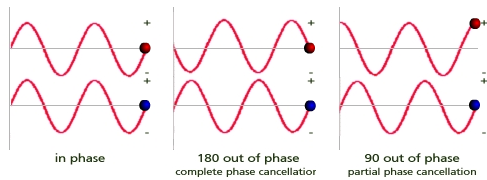Difference between revisions of "Phase Cancellation"
(credit to sfu) |
m |
||
| (9 intermediate revisions by the same user not shown) | |||
| Line 1: | Line 1: | ||
| + | {{Bose Reviewed}} | ||
Phase (cancellation, interference) | Phase (cancellation, interference) | ||
<!-- TODO resolve circular reference to category and this page --> | <!-- TODO resolve circular reference to category and this page --> | ||
| + | {{:Phase Cancellation and the L1}} | ||
| + | |||
| + | |||
| + | === Theoretical Discussion === | ||
Running two inputs 180° out-of-phase puts the peaks and valleys of the sine wave so that they null each other out when summed (see the middle picture below). This has a tendency to cancel out both inputs, and is quite pronounced in the "far" field, but negligible in the "near" field. Normally phase cancellation is undesirable, but when you know what you want (and in this case, what you don't want) then you do it deliberately. | Running two inputs 180° out-of-phase puts the peaks and valleys of the sine wave so that they null each other out when summed (see the middle picture below). This has a tendency to cancel out both inputs, and is quite pronounced in the "far" field, but negligible in the "near" field. Normally phase cancellation is undesirable, but when you know what you want (and in this case, what you don't want) then you do it deliberately. | ||
| − | <html> | + | <!-- dead link looking for replacement |
| + | <html><br /> | ||
<EMBED src="http://www.sfu.ca/sca/Manuals/ZAAPf/splash/phase_diagram.spl" width=490 height=174 | <EMBED src="http://www.sfu.ca/sca/Manuals/ZAAPf/splash/phase_diagram.spl" width=490 height=174 | ||
Loop="True" Play="True" BGColor="ffffff" Quality="Autohigh" Scale="Showall" SAlign=""> | Loop="True" Play="True" BGColor="ffffff" Quality="Autohigh" Scale="Showall" SAlign=""> | ||
| Line 9: | Line 15: | ||
The illustration above is from [http://www.sfu.ca/sca/Manuals/ZAAPf/p/phase.html Phase at SFU]]. Follow the link for a very interesting discussion about Phase. | The illustration above is from [http://www.sfu.ca/sca/Manuals/ZAAPf/p/phase.html Phase at SFU]]. Follow the link for a very interesting discussion about Phase. | ||
| + | |||
| + | --> | ||
| + | |||
| + | [[Image:PhaseIn.png]] | ||
| Line 23: | Line 33: | ||
# Poor imaging | # Poor imaging | ||
| − | See: [http://www.livesoundint.com/archives/2003/july/phase/phase.php Practical Realities of Phase Interference] | + | See: |
| + | There is an interesting visual presentation of [https://www.youtube.com/watch?v=D7aftTF--5w how phase cancellation occurs with two sound sources]. | ||
| + | |||
| + | [http://www.livesoundint.com/archives/2003/july/phase/phase.php Practical Realities of Phase Interference] | ||
| + | ---- | ||
See: [[:Category:Phase|Phase]] | See: [[:Category:Phase|Phase]] | ||
| + | <noinclude> | ||
| + | ---- | ||
| + | <references /> | ||
| + | </noinclude> | ||
Latest revision as of 20:18, 29 August 2023
Phase (cancellation, interference)
Minimum Distance Running Two L1®s in Dual Mono
Phase cancellation can be an issue if you are running Dual Mono (two L1®s from the same mono source). This can be an issue when two or more L1®s are fed the same signal.
The minimum recommended distance for two L1®s running the same signal is 20-50 feet.
Only when fed the same signal, "Interference between line arrays would be more severe [than for non-line-array speakers]. In fact, the current Bose design rules for installing MA12 line arrays recommend ... a spacing between line arrays of between 6 and 15 meters! (20-50 feet)" The same applies to the L1. - Chris-at-Bose [1] (Clarifications added by the author of the quote.)
Note: During a conversation with Chris-at-Bose, he confirmed that the recommendations above are the same for the L1 Model II. ST 15:13, 30 August 2007 (GMT-7)
Theoretical Discussion
Running two inputs 180° out-of-phase puts the peaks and valleys of the sine wave so that they null each other out when summed (see the middle picture below). This has a tendency to cancel out both inputs, and is quite pronounced in the "far" field, but negligible in the "near" field. Normally phase cancellation is undesirable, but when you know what you want (and in this case, what you don't want) then you do it deliberately.
Phase cancellation occurs when two signals of the same frequency are out of phase with each other resulting in either a boost or cut in the overall level of the combined signal.
-- Phase at the Zen Audio Project
If you are suffering from some or all of these, you could be experiencing Phase Interference
- "Hot" and "cold" spots in the audience area
- Tonal coloration
- Poor speech intelligibility
- Lack of music clarity
- Poor gain-before-feedback
- Poor imaging
See: There is an interesting visual presentation of how phase cancellation occurs with two sound sources.
Practical Realities of Phase Interference
See: Phase
